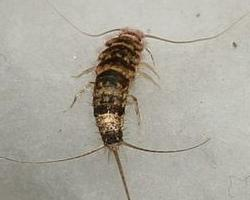
Váhy a míry
| Délka | od 7 do 10 mm |
|---|
Stav ohrožení
| Ohrožen |
Popis zvířete
The silverfish (Lepisma saccharina) is a small, wingless insect belonging to the order Zygentoma. Its name derives from its silvery light grey and blue color, combined with the fish-like appearance of its movements. Silverfish are known for their teardrop or carrot-shaped bodies and scaly, metallic exoskeletons, which give them a shimmering appearance as they move with a characteristic wiggling motion that resembles the swimming action of a fish.Typically measuring between 0.5 to 1 inch (12 to 25 mm) in length, silverfish are nocturnal creatures that have been inhabiting the Earth for over 400 million years, making them one of the oldest surviving insect groups. They possess a trio of long bristles at the rear of their abdomen, which are known as cerci, and two long antennae that protrude from their head, giving them a total of five appendages that extend beyond the body. These features contribute to their alien-like appearance.
The body of a silverfish is flattened and elongated, allowing it to squeeze into tight cracks and crevices where it typically hides during the day. The insect's exoskeleton is covered with tiny scales that are frequently shed and regenerated throughout its life, which can span from two to eight years.
Silverfish are known for their voracious appetites, particularly for carbohydrates and proteins. They consume a wide range of materials but are especially attracted to paper, glue, clothing, carpet, and food items such as flour and oats. This diet makes them common pests in human dwellings, where they can cause damage to books, wallpaper, insulation, and clothing.
One of the most fascinating aspects of silverfish is their reproductive behavior. Males and females engage in a ritual that involves three phases: the male and female stand face to face, then the male runs away and the female chases him, and finally, the male deposits a spermatophore (a sperm capsule), which the female takes into her body to fertilize her eggs. Females lay small clusters of eggs in cracks and crevices, and the young nymphs that hatch resemble miniature adults but without the characteristic silver scales, which develop as they mature.
Silverfish prefer environments with high humidity and can often be found in damp, cool places such as basements, bathrooms, kitchens, and laundry rooms. They are most active at night and can run very quickly. Despite their preference for moist environments, silverfish are known for their ability to survive in almost any climate, including dry environments, as long as they have access to water.
Although silverfish are not harmful to humans in terms of disease transmission, their presence can be a nuisance, and their feeding habits can lead to the destruction of personal property. Control measures often involve reducing humidity, sealing cracks and crevices to limit their hiding places, and using traps or insecticides.
In summary, the silverfish is a unique and ancient insect with a distinctive appearance and interesting behaviors. Its adaptability and resilience have allowed it to thrive for millions of years, although its presence is often less than welcome in human homes where it can become a persistent pest.
Podobná zvířata
Nové fotografie zvířat
Top 10 zvířat
- Dolphin gull (Leucophaeus scoresbii)
- Diana monkey (Cercopithecus diana)
- Japanese macaque (Macaca fuscata)
- Stone loach (Barbatula barbatula)
- Galápagos tortoise (Geochelone nigra complex)
- Moustached guenon (Cercopithecus cephus)
- Russian tortoise (Testudo horsfieldii)
- Common house mosquito (Culex pipiens)
- Giant peacock moth (Saturnia pyri)
- Japanese spider crab (Macrocheira kaempferi)
